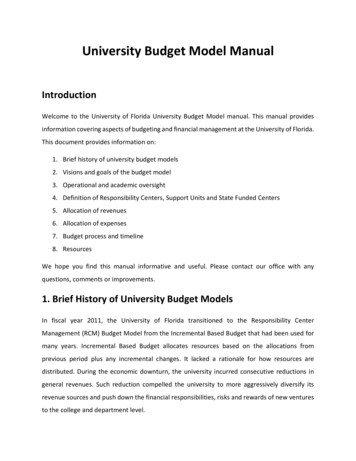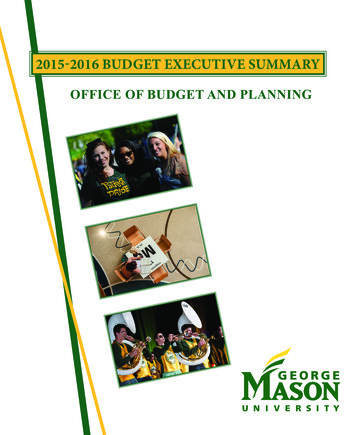
Transcription
University Budget Model ManualIntroductionWelcome to the University of Florida University Budget Model manual. This manual providesinformation covering aspects of budgeting and financial management at the University of Florida.This document provides information on:1. Brief history of university budget models2. Visions and goals of the budget model3. Operational and academic oversight4. Definition of Responsibility Centers, Support Units and State Funded Centers5. Allocation of revenues6. Allocation of expenses7. Budget process and timeline8. ResourcesWe hope you find this manual informative and useful. Please contact our office with anyquestions, comments or improvements.1. Brief History of University Budget ModelsIn fiscal year 2011, the University of Florida transitioned to the Responsibility CenterManagement (RCM) Budget Model from the Incremental Based Budget that had been used formany years. Incremental Based Budget allocates resources based on the allocations fromprevious period plus any incremental changes. It lacked a rationale for how resources aredistributed. During the economic downturn, the university incurred consecutive reductions ingeneral revenues. Such reduction compelled the university to more aggressively diversify itsrevenue sources and push down the financial responsibilities, risks and rewards of new venturesto the college and department level.
The model was intended to create incentives for entrepreneurial behavior at the unit level.Revenues from entrepreneurial activities are retained entirely by those units undertaking suchentrepreneurial risks. That activity must fall within the strategic scope and meet the strategicgoals of the university.Support unit costs are paid by overhead assessments. All revenues are allocated to responsibilitycenters. Therefore, responsibility centers must pay for the services provided to them through anallocation or assessment system. The unit can pay its invoice from any resource that it deemsappropriate except for endowment and gift funds.After six years of RCM implementation, in fiscal year 2016, RCM was reviewed and revised. TheBudget Review Steering Committee and Task Force identified common issues and determinedsolutions to simplify the model, made the model more predictable, and ensured its alignmentwith university strategic goals. The guiding principle of the budget model is to make revenue andoverhead allocation as simple as possible by providing clear and predictable calculations.Three major changes include:1. Allocate collected tuition revenue directly to the colleges.2. Assess fixed percentage of IDC for Sponsored Project Administration cost based on a tierstructure.3. Assess fixed percentage of IT/General Administration overhead.These changes make budgets simpler, more transparent, and affords up front planning timesfor the units. The newly revised model took effect in fiscal year 2017 and now is referred as theUF Budget Model. The detail of this new model is explained in the following sections.2. Visions and Goals of the University Budget ModelVisions Each Responsibility Center will have its own revenue streamsEach Responsibility Center will be responsible for managing its revenue and full costs
Each Responsibility Center will benefit directly from the success of its initiatives andentrepreneurial activities that increase revenue or decrease operating expensesThe university will maintain a strategic fund to support new initiatives, rewardexcellence and promote the university’s missionGoals Provide decision-makers with increased transparency into the university’s finances andfoster an information rich discourse on college priorities and budget mattersCreate appropriate incentives that advance the university’s strategic goalsAllow Responsibility Centers to keep revenues that they generateAlign responsibility and authority over fiscal matters.3. Operational and Academic OversightThe President of the University provides oversight for the university as a whole. The ChiefFinancial Officer serves as the chair of the university budget model. Any changes to the budgetmodel require the approval of the President. For continuous evaluation of the principles,objectives and algorithms, budget review committee is formed by the deans of the colleges, arepresentative of each vice president and the Chair of the Faculty Senate. The office of each vicepresident provides oversight for those RC units reporting to him/her and ensures that unitbudgets reflect priorities as set for by the university. The Provost/Senior Vice President forAcademic Affairs, Senior Vice President for IFAS, and the Senior Vice President for Health Affairsare responsible for leading the academic planning process and ensuring academic quality.The Faculty Senate is the representative body of the faculty. It operates according to theprinciples of shared governance, a constitutionally created system of mutual authority andresponsibility, which recognizes the faculty’s central role in enhancing UF’s intellectual profile aswell as the quality and value of the education it provides to students from both the State ofFlorida and throughout the world.The Budget Council, a sub-committee of the Faculty Senate, is responsible for reviewing budgetand fiscal matters as they involve the academic mission of the university, includingrecommendation of budget priorities involving academics and research, the fiscal implications of
creation, modification or delete of academic programs, the collection of dissemination ofinformation about the university budgeting and planning; and monitoring whether the allocationof resources is consistent with Faculty Senate actions and the university’s long term and shortterm strategic plans.4. Definition of Responsibility Centers, Support Units and StateFunded CentersResponsibility CentersBy definition, Responsibility Centers must generate revenues. If an area is identified as aResponsibility Center, that unit is responsible for all financial decisions as well as managingrevenues, expenditures and fund balances. At the University of Florida the following areas areidentified as Responsibility Centers:Colleges College of Agricultural and LifeScienceCollege of the ArtCollege of Business AdministrationCollege of DentistryCollege of Design, Construction andPlanningCollege of EngineeringCollege of Health and HumanPerformanceCollege of Journalism andCommunications College of LawCollege of Liberal Arts and SciencesCollege of MedicineCollege of NursingCollege of PharmacyCollege of Public Health and HealthProfessionsCollege of PHHP-MedicineCollege of Veterinary MedicineFlexible LearningUF Center for Latin American StudiesAuxiliaries (Major Units) Academic TechnologyAnimal Care ServicesBaby GatorBaughman CenterBiotechnology Research (ICBR) BookstoreBureau of Economic & BusinessResearch (BEBR)Business ServicesCenter for Epigenetics
Computer Network ServicesCounselling & WellnessDentistry Instrument ManagementDivision of Continuing Education(Self-Funded Programs)Document ServicesEnterprise Infrastructure OperationsEnvironmental Health & SafetyFacilities Services (Working CapitalTrust Fund)Florida Museum for Natural HistoryGatorWellHealthNetHousingHSC IT SupportID Card ServicesJ Wayne Reitz UnionLaundry ServicesMandatory Health InsuranceMcKnight Brain Institute-AMRIS McTransCenterMD-CTSI Research CenterMD-Orthopaedics Institute RentNew Student Programs-PreviewPhilips Center for the PerformingArtsRecreation SportsResearch ComputingStephen O’Connell CenterStudent GovernmentStudent Health Care CenterTransportation and ParkingUniversity AuditoriumUniversity of Florida InternationalCenterUniversity Florida PressUPD Special EventsVeterinary Medicine TeachingHospitalSupport UnitsSupport Units (SU) are divided into cost pools. The cost pool determines the cost allocationmethod. Responsibility Centers are not permitted to “opt-out” of services to reduce the serviceand support expenses charged to their unit. Colleges will determine how SU assessments areallocated to the departments. The eight cost pools and the affiliate SUs are as follows:Information Technology Chief Information OfficerGeneral Administration AIMBoard of TrusteesBusiness ServicesCenter for Innovation and OnlineProductionCenter for Precollegiate Education CFO Shared Service CenterChief Financial OfficerEmergency ManagementEnvironmental Health and SafetyFaculty DevelopmentFinance and Accounting
General CounselGeneral Expense-InsuranceGeneral Expense-OtherGovernment RelationsHonors OfficeHuman ResourcesInstitute Online LearningOffice of Institutional Planning andResearchOffice of Internal AuditOffice of SustainabilityOffice of Teaching and TechnologyOffice of the Provost Office of the Vice President forBusiness AffairsProcurement ServicesReal EstateSmall Bus/Vendor Diversity RelationsStephen O’Connell CenterStrategicCommunicationsandMarketingStudent Health Care CenterSVP-AdministrationUF PrivacyUndergraduate AffairsUniversity Budget OfficeUniversity Police Planning Design and Construction Finance and AccountingResearch Student AffairsStudent Financial AffairsStudent GovernmentUniversity of Florida InternationalCenter HSC Libraries Facilities Facilities ServicesHSC Administration Health AffairsSponsored Project Administration Environment Health and SafetyFacilities ServicesStudent Services Career Resource CenterCounseling CenterDean of StudentsEnrollment managementGraduate SchoolStudent Activities & InvolvementLibrary Services University Libraries
Bond Payment ResearchState Funded CentersThese are the units managed by the University of Florida for the benefit of the state. Stateappropriated funds are provided to them directly. Their budget is still incremental based, onlychanges when receiving new state funding or budget reduction. Animal Care ServicesBiotech Develop IncubatorBiotechnology-ICBRBiotechnology-Biotech Res/DevelopInstBureau of Economic and BusinessResearchCancer CenterCenter for Smell and TasteCenter for Excellence forRegenerative Health BiotechnologyDigital WorldsEmerging Pathogens Florida Sea GrantHarn MuseumInstitute of Child Health PolicyInterdisciplinary Program DMcKnight Brain InstituteMedicine-JacksonvilleMilitary SciencesPhilips Center for the PerformingArtsUniversity AuditoriumUniversity Florida PressWater InstituteWhitney LabsHybrid UnitsYou may have noticed some of the units are hybrids. They function as both a Responsibility Centerand a Support Unit or as a Responsibility Center and a State Funded Center. For example, theInternational Center, as a support unit, provides international student services and assists allinternational students with the required immigration documents to study in the United State andmaintain their legal non-immigration status while residing in the US. As a Responsibility Center,the International Center provides study abroad services to UF students and faculty. It managesthe study abroad application process, the fee allocation and expenditure transactions.
Animal Care Services receives state funds directly as a State Funded Center. It also conductsauxiliary activities by providing animal care services to the university community as aResponsibility Center.5. Allocation of RevenuesLook Back periodThe university uses the prior calendar year data for tuition allocation. For example, the tuitioncollected in Spring 18, Summer 18 and Fall 18 is allocated for fiscal year 2020’s operation. Theuniversity uses prior calendar year expenditure data for overhead assessment. For example, theexpenditures occurred between 1/1/2018 and 12/31/2018 is used for FY20 overhead allocation.Tuition AllocationUnder the current budget model, the collected tuition is allocated directly to the colleges, 70%by teaching and 30% by enrollment. The collected tuition is in net of all waivers. If a collegegrant Graduate Assistants (GA) waivers in any of the terms when the tuition is collected, itstuition allocation will be reduced by the same amount. Other waivers such as university waiversand statutory mandated waivers are also impacting the collected tuition amount.As mentioned earlier, the undergraduate out-of-state fee is allocated separately to create astrategic pool for the Provost. However, the lion’s share of this fee is returned to colleges whenthe budget model was revised in FY17. The incremental amount since then all contributes tothe strategic pool.Tuitions from several programs are handled differently, including: Innovation AcademyUFOnlineCommon CourseFlexible LearningExchange ProgramMilitary Sciences
The university launched the Innovation Academy program in 2012. Students in this program areenrolled in the spring-summer academic year and have fall semester off-campus. This programis focused on innovation, creativity, entrepreneurship, ethics and leadership. The first cohort ofenrolled students started in the spring term of 2013. All tuition from this program is allocatedto the department of Innovation Academy. UFOnline tuition is handled similarly - directly goesto UF Online department.Common Course refers to course IUF1000: “What is the Good Life”. This interdisciplinary courseis co-developed by the Division of Continuing Education (DOCE) and various colleges. Therevenue is allocated 100% to DOCE. DOCE then allocates the funding to the colleges based onagreed upon percentages and amounts.Flexible Learning courses (or Correspondence Study courses) are also collaboratively developedby DOCE and many other colleges. The 70% revenue by teaching is allocated to DOCE and the30% of the revenue is allocated to the college that helped in creating the courses.For the exchange program, UF Students who study abroad registers for course IDS4956 which isunder College of Liberal Arts and Sciences. Therefore, 70% of the revenue by teaching thiscourse would be allocated to College of Liberal Arts and Sciences even though no teaching isconducted in this college. We manually changed the teaching college to the colleges where thestudents identify their majors. Therefore the revenue generated by this course, flow to thosecolleges.Tuition collected from ROTC courses was allocated to colleges through General FundsSupplement (GFS) in FY17 when the budget model was revised. The increases/decreases sincethen are eliminated from the tuition allocation process.Some components of the tuition are required by law to be distributed for specific purpose. In2007, the Florida legislature passed a bill that allowed UF to raise undergraduate tuition up to15% per year. The 15% includes a legislatively established increase in base tuition and aremainder tuition differentia set by the University of Florida Board of Trustees. The remainderof the increase is what we call Undergraduate Differential Tuition. 30% of the differentialtuition goes to student financial aid. We pull this out before distributing the tuition to colleges.
Another component of the tuition that we pull out is 2005 flex. The legislature approved atuition increase effective fall 2005 and 20% of the increase is required to go to need-basedfinancial aid.The tuition data set is derived from Enrollment Revenue Cube which is managed and built byOffice of Institutional Planning and Research. It is under Enterprise Reporting- AccessReporting- Institutional Research- Enrollment Revenue folder. This cube contains threesnapshots of the tuition information per semester: fee deadline, preliminary, and final. Finaldata is used in the tuition allocation process.State Appropriation AllocationUnder the new budget model, colleges receive state appropriation through the General FundsSupplement (GFS) and other special line item allocationsAs we transition to the UF Budget Model, to keep the funding levels the same for colleges, aGeneral Funds Supplement was created. Each college receives certain amounts of GFS fromstate appropriation to “hold them harmless”. The amount is calculated so that the college willreceive the same amount of net budget when the tuition allocation and the IT/GA and facilityoverhead are changed. Colleges should not expect GFS to be reduced going forward unless theuniversity incurs budget cut from the state or any other unforeseen situation occurs. This fund,as a steady income stream, should help colleges’ plans and projections easier. GFS may go upbecause of recurring increases such as faculty and staff raise, fringe benefit changes, etc. Goingforward, the President, Provost and Senior VPs will make strategic decisions allocating anyadditional increases or decreases in state appropriations, which in turn, may impact thecollege’s GFS amount.Special line items are part of the state appropriation that are allocated for specific program orpurpose. Such line items including Dean’s startup, program support, legislative specials, PO&M,Preeminence funding, Work Class Faculty funding, Professional Graduate Degree funding, UFOnline funding etc.Other Revenue
All other revenue such as Contracts & Grants, clinical practice, auxiliary, etc. go directly to therevenue generating units.6. Allocation of ExpensesOverheads are costs charged or assessed to responsibility centers, state funded centers andspecific support units to pay for services provided by support units. Overhead assessments aregrouped into eight cost pools. Each pool corresponds to specific support unit functions andservices. Information Technology (IT)General AdministrationFacilitiesHSC AdministrationSponsored Project AdminStudent ServicesLibrary ServicesBond PaymentOverhead is assessed differently depending on the support unit cost pools. Different factors areused for overhead assessment such as expense, revenue, space, IDC returns etc. Below tablesummarizes what factors effect each SU pool overhead assessments to the responsibilitycenters.Information Technology/ SC Administration(HSC Admin)* State Funds: Budget Year StateRevenue* State Funds: Budget Year StateRevenue* Non-State Funds: Past Cal. Yr.Expenditure* Non-State Funds: Past Cal. Yr.Expenditure* State Funds: 10%* Non-State Funds: 13%* Exceptions:Clinical Practice - 1.1%IFAS - 1.61%Student Government - 10%Seed Producer - 9.97%Self Insurance Program - 4.94%UF Foundation - Excluded* State Funds: 1.97%* Non-State Funds: 2.37%* Exceptions:UF Foundation - ExcludedScholarship/Grant Funds - ExcludedTransfers - ExcludedOnly Applies to HSC CollegesFacilitiesSpace SQFT* Lab: 30.61* Classroom: 16.70* Office: 13.91* Others: 11.13
Scholarship/Grant Funds - ExcludedTransfers - ExcludedIT/General Admin (IT/GA)The IT/General Admin unit cost pools assessment responsibility centers and other units basedon revenues (state funds) or expenses (non-state funds). Each year, during the budgetallocation process, the colleges’ state fund amount is calculated, then 10% of that revenue iscollected for the IT/GA overhead. The balance of the state funds is then released to thecolleges. Expenditures from non-state funds for all units for the previous calendar year arereviewed and calculated, then a rate of 13% is collected for the IT/GA overhead monthly duringthe fiscal year. Expenses coming from state funds are not charged again since they are alreadycharged the 10% when they initially receive that revenue.HSC AdminThe HSC Admin pool works similarly to the IT/GA pool. However, the difference is that chargesare only applied to the Health Science Center colleges. The HSC Admin rate is evaluated eachyear. This rate is on top of the addition to the IT/GA overhead for the HSC colleges. The rate tothe state funds is around 2% and the one to the non-state funds is around 2.5%.FacilitiesThe cost of operating facilities is assessed directly to the unit that “owns” the space. There aretwo components included in the facility support costs: utilities and plant operations. Plantoperations cover maintenance, custodial, groups, landscaping, refuse and recycling. Facilitiesoverhead is based on square footage, not on expense or revenue.The space data is provided by University Planning, Design and Construction and is derived fromthe Space Tracking & Reporting System (STARTS) and Space Inventory & Allocation System
(SPIN). The most recent available space data is used to calculate overhead. For example, FY20overhead is calculated based on 2018 space survey data. University space is categorized intofour groups. Each has a different weighting factor depending on the level of consumption ofresources.Space e facility overhead rate is calculated as the ratio of facilities support units’ budget over thetotal taxable weighted SQFT. Not all spaces are subject to facility overhead. Units that managetheir own facilities are exempted from this tax. Below is a summary of what spaces are includedin this tax and what spaces are not.AssessedE&G BuildingsHSC BuildingsClassroomsLabsOfficesOthersConference RoomsStudy RoomsCentral StorageAthletic Phys EDTreatment/ExaminationOthersNot AssessedIFAS BuildingsUAA BuildingsShands BuildingsHousingNon-SUS BuildingsFraternity/SororityPK Yonge BuildingsOther Buildings that pay bills directlyPass Through Buildings (St. Aug. Buildings,Lake Nona etc)Mechanical RoomsHallway, Stairs and BathroomsTelephone RoomsElevatorsOthersPO&M for New Space and Auxiliaries in E&G SpaceWhen RCM started, most of the PO&M was allocated to the colleges and they, in turn, usedthat funding to pay for their facility overhead. There was a small portion of the PO&M that wastaken off the top and allocated based on various factors. A portion of the off-the-top PO&M is
allocated to reported “new space”. The “new space” is space either under construction orvacant ready-to-occupy or newly occupied but not reported space when RCM started. Thesenew spaces may not be new anymore today. However, since the associated facility costs werenot built into the college’s initial allocation under the old RCM model, the PO&M for these newspaces are allocated separately. When the new building is occupied and reported, facilityoverhead will be assessed. The related PO&M will be allocated to the units that are using thespace. If a support unit or a state funded center occupies the space, the related PO&M will beallocated to the Provost for strategic initiatives.If a department conducts auxiliary activities in an E&G or HSC building, this department will beassessed facility overhead. However, they will be compensated to offset the assessment. Thereason being is that if a building receives PO&M funding, the funding should be aimed to coverthe facilities cost.Sponsored Project Admin (SPA)Under the UF Budget Model, accrued Indirect Cost (IDC) is allocated to colleges or units afterdeducting a certain percentage for overhead. The colleges and units are categorized into fourtiers. Each tier is assessed a different percentage based on the amount of research activities topay the SPA overhead. High research intensity, high in-units research infrastructure units pay alower percentage of their IDC returns toward SPA overhead. In contrast, low research intensity,low or no in-unit infrastructure units pay a greater share of their IDC to SPA overhead. Eventhough, it is a higher percentage, the absolute amount these units pay is much less than theunits that pays a lower percentage.TierTier 1 (36.8%)Units College of Dentistry College of Engineering College of Health and Human Performance College of Liberal Arts and Sciences College of Nursing College of Pharmacy
CollegeofPublicHealthandHealthProfessionsTier 2 (49%)Tier 3 (53.5%)Tier 4 (75%) College of PHHP-COM Florida Museum of Natural History Latin American studies Whitney Lab College of Medicine College of Medicine – Jacksonville College of Veterinary Medicine Institute for Child Health Policy College of the Arts College of the Business College of the Design, Construction & Planning College of Education College of Journalism and Communications College of Law Harn Museum of Art IFAS Info Technology International Center Libraries Research Sea Grant DOCE Enrollment Management EH&S Facilities Services Finance and Accounting Graduate School Health Affairs Provost Office Student Affairs Student Health Care Center University Press
As the research portfolio grows, this model allows the available resources for central researchservices supported by SPA overhead to increase proportionally to IDC growth. In addition, thesame group of units will need to be able to withstand fluctuations and downwards in IDC in anygiven year.Library Services and Student ServicesLibrary Services and Student Services are funded by the Provost directly.Bond PaymentBond Payment is the Cancer/Genetics bonding assessment to College of Liberal Arts andSciences, College of Medicine, and College of Agricultural and Life Sciences. The Division ofSponsored Programs manages this overhead.Support units are required to abide within the limits of what is collected. However, significantunfunded mandates may require special assessments. If there is any excess overhead, it will bereviewed by the President or Provost and maybe used strategically for certain support unitareas.Expenditure Exempted from Overhead AssessmentNot all expenditures are subject to overhead assessment. Major exemptions include: Transfers (GL account 8XXXXX)Expenditures Over 100K per transactionInternal salesDistance learning feeExpenditures on payment to Apollidon, All Compass LLC, NCS Pearson Inc and PersonEducation Inc.Expenditures from Foundation, Scholarship and Contracts & GrantsExpenditures over 100K per transaction includes transactions that contain several lines ofpayments from different chartfield strings.
Internal sales are used to off-set the overhead assessed to a unit’s direct expenditures. Forexample, if Animal Care Services (ACS) has 2M direct expenditures, 1.5M internal salerevenues, no over 100K transactions, no transfers, only 0.5M is assessed. The reason being isthat the departments who use ACS’ services incur some expenditures that will be taxed. If ACSwho provides the services is taxed, we will have double taxation. Removing internal sales allowsonly one tax to the unit where the true expenditures occurs.7. Budget Process and TimelineEach year during the Nov-Jan time frame, the support units will go through the SU BudgetRequest cycle for the next fiscal year. It is the time of the year for the SUs to request how muchfunding they need to operate in the new fiscal year. In a regular year, the SUs submit a flatbudget and an optimal budget. If the university budget is going down, the SUs may need toprovide a budget cut scenario.All the requests are submitted through UF’s Budget system – Hyperion. The President, theProvost and the Senior VPs will then review and approve the requests and finalize the budgets.March to April time frame overhead assessments to non-state funds will be calculated. By earlyMay, the university should receive the final state budget. The University Budget Office will thencalculate the budget controls to each college, state funded centers and support unit. Sometimebetween May and June, Hyperion opens to all units to enter their budget for all their funds forthe new fiscal year. Around June, the budget control numbers are released.Spending authority is entered in myUFL Commitment Control before the new fiscal year starts.All Funds Budget data along with the past year actual data is then reviewed and reported to thestate.8. ResourcesUniversity Budget Office:George Kolb, Assistant Vice President, gkolb@ufl.eduJulie Wang, Director, University Budgets, wangj@ufl.edu
Amber Allen-Ingram, Assistant Director, Ameldot2@ufl.eduOffice phone: 352-392-2402Website: -analysis-and-budget/University Budget Model training course: UBM100
to UF Online department. ommon ourse refers to course IUF1000: "What is the Good Life". This interdisciplinary course is co-developed by the Division of Continuing Education (DOCE) and various colleges. The revenue is allocated 100% to DOCE. DOCE then allocates the funding to the colleges based on agreed upon percentages and amounts.











